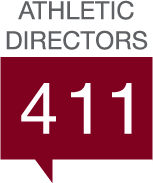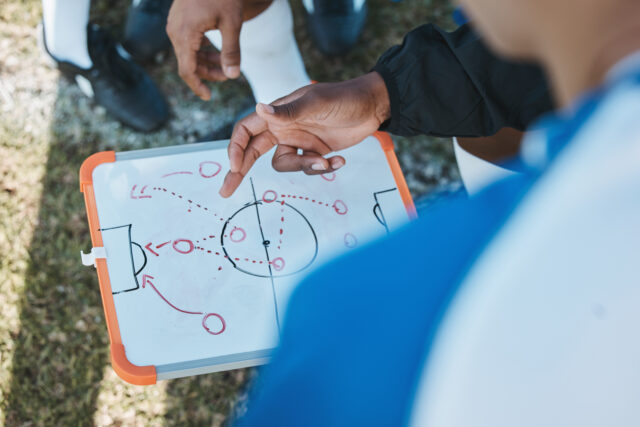General managers. You’ve seen it in the headlines, you’ve heard it on the news—so many college sports programs seem to be hiring a general manager these days. Former ESPN insider Adrian Wojnarowski was hired as St. Bonaventure basketball’s general manager, Andrew Luck joined Stanford football as the general manager, while Courtney Morgan signed a three-year contract with Alabama, earning him an $825,000 annual salary. As amateurism in college sports continues to decline, the creation of new roles and new responsibilities for athletics programs seems to increase. Everywhere you look, another big sports program seems to be adding a general manager to their arsenal—but what exactly is a general manager in college sports? And how could this translate to the smaller, more budget-conscious athletics programs?
The Role of the General Manager
In pro sports, the role of general manager is clear: they are the head of operations, leading the scouting department, handling free agent transactions and contract negotiations. A GM of a professional sports team is often in charge of hiring coaches, where they both report to the owner. In college sports, however, the position’s responsibilities—and hierarchy—blur.
So far, we’ve seen GMs in college sports assigned to specific programs (mainly football or men’s basketball) taking on a variety of roles such as scouting, recruitment help, community outreach and NIL fundraising. Unlike in professional sports, a collegiate general manager reports to the coach, who, in turn, reports to the AD and university leaders. Schools like Michigan and Stanford have added “NIL general managers” to the professional rosters to specifically handle NIL deals and negotiations while some programs, like Stanford football, hired a general manager to oversee the football program, assist in recruiting and roster management, fundraising, alumni relations, sponsorships, student-athlete support and stadium experience.
Across the nation, we’ve seen new roles added to collegiate athletics programs. Illinois State University appointed a “Director of NIL and Community Engagement”, Washington State University added a “Director of Student-Athlete Innovation”, and Notre Dame has a “Director of Student-Athlete Management in NIL Division”. While the positions might not hold the same title, they wear the same hats in helping athletic programs adapt to college sport’s new era of NIL, branding and professionalism.
Implementation in Non-Power 5 Conferences
The trend of hiring general managers and NIL specialists has gained momentum, particularly within the Power 5 conferences and larger schools, to manage complex tasks like roster construction, recruitment and NIL navigation. It’s clear that extra help is necessary with the momentous changes coming to college athletics like revenue-sharing, NIL, and the transfer portal but for smaller, non-Power 5 conferences, adopting this model presents both challenges and potential advantages.
- Resource Allocation: Non-Power 5 schools typically operate with more limited budgets compared to their Power 5 counterparts. Allocating funds to hire a specialized role necessitates careful financial planning, especially when these schools are already managing increased expenses without the benefit of substantial media rights revenues.
- Role Adaptation: In these institutions, a general manager (or other)’s role might be more expansive, encompassing responsibilities beyond recruitment and roster management to include fundraising, community engagement, alumni relations and enhancing athlete support services. This multifaceted approach can help maximize the impact of the position within budget constraints.
- Strategic Advantage: A dedicated GM can provide a strategic edge by focusing on talent identification and retention, particularly in the current landscape where the transfer portal and NIL opportunities have intensified competition for athletes. This focus is crucial for non-Power 5 schools striving to remain competitive.
Steps to Evaluate If Your Program Needs a GM
- Assess Staff Workload: Identify areas where existing staff are stretched too thin.
- Pinpoint Gaps: Determine whether your program struggles with NIL management, recruitment or alumni relations.
- Calculate ROI: Evaluate how a GM could boost program efficiency and athlete support.
- Set Clear Goals: Define the specific outcomes you’d expect from hiring a GM.
Fitting a New Role into Your Program
As college athletics evolve, so must the organizational structures of athletic departments. The GM role is no longer exclusive to professional sports; it’s now a pivotal position in collegiate programs for managing NIL, recruitment and athlete support. While Power 5 programs have embraced this trend, smaller schools can benefit just as much by tailoring the role to fit their specific needs.
Whether focusing on alumni relations, NIL opportunities or community engagement, a GM can streamline operations and offer better support for student-athletes. The decision comes down to evaluating your program’s challenges, goals, and financial capacity to invest in this critical position.
The real question isn’t whether your program can afford a general manager—it’s whether you can afford to go without one.




